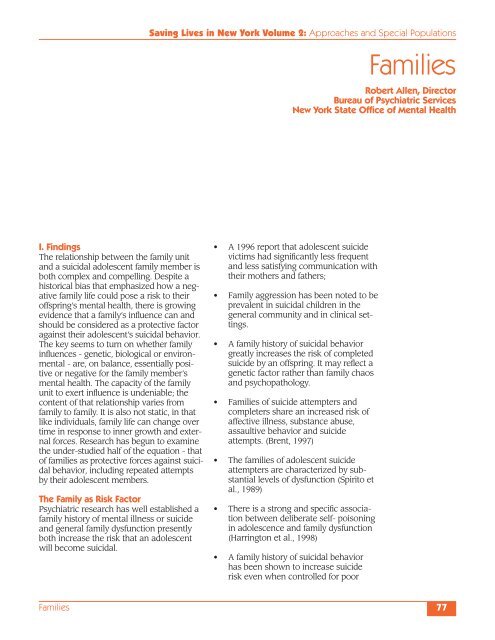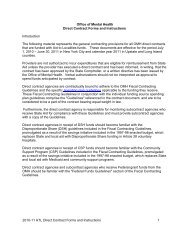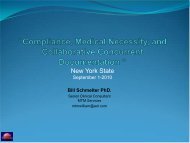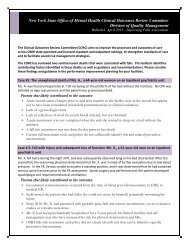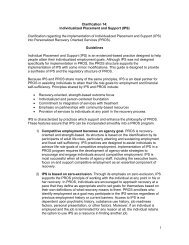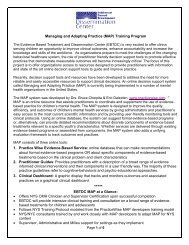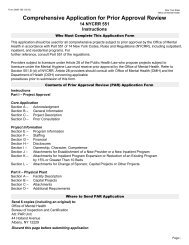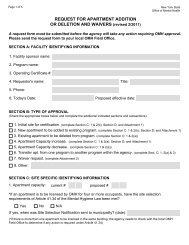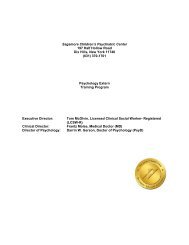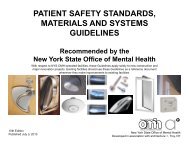Download - New York State Office of Mental Health
Download - New York State Office of Mental Health
Download - New York State Office of Mental Health
You also want an ePaper? Increase the reach of your titles
YUMPU automatically turns print PDFs into web optimized ePapers that Google loves.
Saving Lives in <strong>New</strong> <strong>York</strong> Volume 2: Approaches and Special Populations<br />
Families<br />
Robert Allen, Director<br />
Bureau <strong>of</strong> Psychiatric Services<br />
<strong>New</strong> <strong>York</strong> <strong>State</strong> <strong>Office</strong> <strong>of</strong> <strong>Mental</strong> <strong>Health</strong><br />
I. Findings<br />
The relationship between the family unit<br />
and a suicidal adolescent family member is<br />
both complex and compelling. Despite a<br />
historical bias that emphasized how a negative<br />
family life could pose a risk to their<br />
<strong>of</strong>fspring’s mental health, there is growing<br />
evidence that a family’s influence can and<br />
should be considered as a protective factor<br />
against their adolescent’s suicidal behavior.<br />
The key seems to turn on whether family<br />
influences - genetic, biological or environmental<br />
- are, on balance, essentially positive<br />
or negative for the family member’s<br />
mental health. The capacity <strong>of</strong> the family<br />
unit to exert influence is undeniable; the<br />
content <strong>of</strong> that relationship varies from<br />
family to family. It is also not static, in that<br />
like individuals, family life can change over<br />
time in response to inner growth and external<br />
forces. Research has begun to examine<br />
the under-studied half <strong>of</strong> the equation - that<br />
<strong>of</strong> families as protective forces against suicidal<br />
behavior, including repeated attempts<br />
by their adolescent members.<br />
The Family as Risk Factor<br />
Psychiatric research has well established a<br />
family history <strong>of</strong> mental illness or suicide<br />
and general family dysfunction presently<br />
both increase the risk that an adolescent<br />
will become suicidal.<br />
• A 1996 report that adolescent suicide<br />
victims had significantly less frequent<br />
and less satisfying communication with<br />
their mothers and fathers;<br />
• Family aggression has been noted to be<br />
prevalent in suicidal children in the<br />
general community and in clinical settings.<br />
• A family history <strong>of</strong> suicidal behavior<br />
greatly increases the risk <strong>of</strong> completed<br />
suicide by an <strong>of</strong>fspring. It may reflect a<br />
genetic factor rather than family chaos<br />
and psychopathology.<br />
• Families <strong>of</strong> suicide attempters and<br />
completers share an increased risk <strong>of</strong><br />
affective illness, substance abuse,<br />
assaultive behavior and suicide<br />
attempts. (Brent, 1997)<br />
• The families <strong>of</strong> adolescent suicide<br />
attempters are characterized by substantial<br />
levels <strong>of</strong> dysfunction (Spirito et<br />
al., 1989)<br />
• There is a strong and specific association<br />
between deliberate self- poisoning<br />
in adolescence and family dysfunction<br />
(Harrington et al., 1998)<br />
• A family history <strong>of</strong> suicidal behavior<br />
has been shown to increase suicide<br />
risk even when controlled for poor<br />
Families 77


